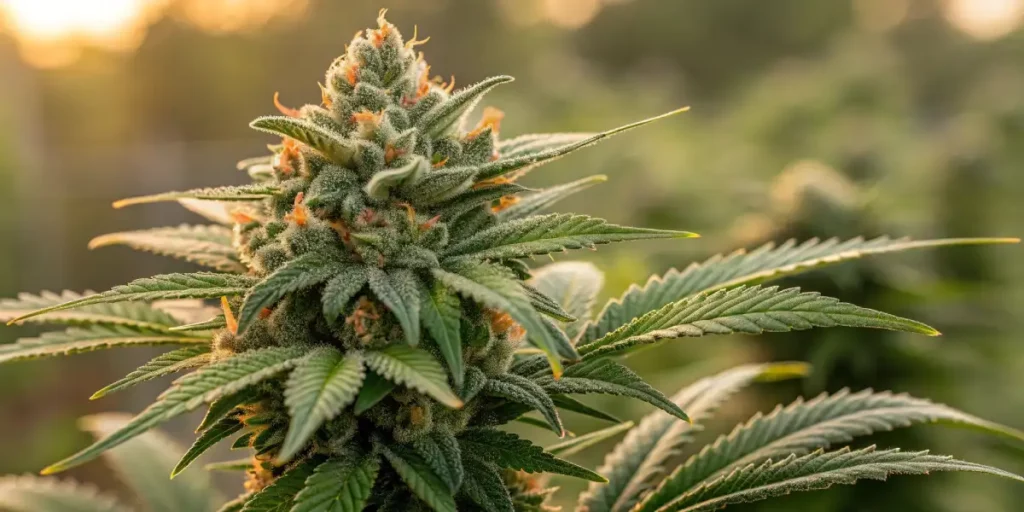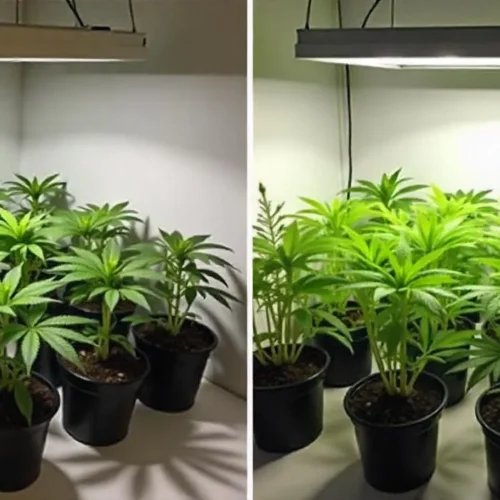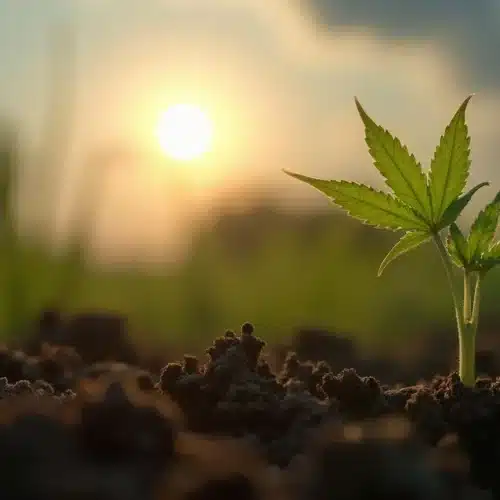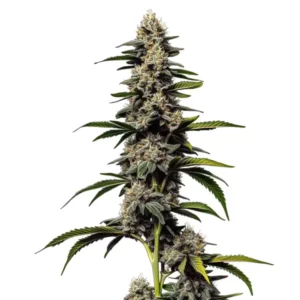Banana Kush Weed Strain Description
Banana Kush is a hybrid strain leaning towards indica dominance, usually featuring a 60/40 indica to sativa ratio. Its genetics stem from a flavorful mix of Ghost OG (also known as OG Kush) and Skunk Haze. This lineage gives Banana Kush its signature sweet, fruity profile highlighted by a distinct banana scent and taste.
Banana Kush Weed Strain is a hybrid cannabis variety cherished for its remarkable banana-like aroma and strong psychoactive effects. It originates from a cross between the famous Ghost OG and Skunk Haze, blending the best of both Indica and Sativa traits. This hybrid is slightly Indica dominant, with a genetic composition of approximately 60% Indica and 40% Sativa, making it an ideal strain for users looking for a balanced high that relaxes the body while stimulating the mind.
Recommended Strains
Banana Kush
 THC: 17% - 21%
THC: 17% - 21% Type of seed: Feminized
Type of seed: Feminized Phenotype: Mostly Indica
Phenotype: Mostly Indica Day to flower: 8 - 9 weeks
Day to flower: 8 - 9 weeks
Known for its appealing appearance, Banana Kush Strain’s buds are dense and covered in a thick layer of trichomes, giving them a frosty, shimmering look. The flowers typically have a bright green hue with yellow-orange pistils, and they exude a sweet, tropical fragrance reminiscent of ripe bananas, thanks to the high levels of terpenes such as limonene and myrcene.
In terms of potency, Banana Kush Strain boasts a THC concentration that can range from 18% to as high as 25%, making it a robust strain suitable for both recreational and medicinal cannabis users. The high kicks in relatively quickly, offering an initial burst of euphoria that transitions into a deep sense of relaxation. Medicinal users often turn to Banana Kush Weed Seeds to help alleviate chronic pain, insomnia, stress, and anxiety. In addition to its effects, those seeking banana kush strain grow info will appreciate its moderate cultivation difficulty, making it a rewarding option for intermediate growers. The strain’s balance between mental stimulation and body relaxation makes it versatile for day or evening use, depending on the dosage.
Promos & Deals
Environmental Requirements for Growing Banana Kush Weed Strain
This Strain thrives in controlled environments where the temperature and humidity can be closely monitored. Whether you grow it indoors or outdoors, providing the right conditions is essential for achieving optimal yields and potent buds. If you’re wondering, ‘is Banana Kush strong?’ this strain is known for its potent effects, especially when grown in a warm and sunny climate, similar to what you would find in Mediterranean regions.
For indoor grows, it’s essential to maintain temperatures between 70-80°F (21-27°C) during the day and a slightly cooler range at night. Keep humidity levels between 40-50% during the vegetative stage, dropping it to 30-40% during the flowering phase to prevent mold or mildew. A well-ventilated grow space with oscillating fans and an exhaust system is crucial for Banana Kush Weed Seeds to thrive. Indoor growers should use high-quality LED lights or HPS lamps to provide adequate lighting. A light cycle of 18-20 hours during the vegetative phase is ideal, switching to 12 hours of light and 12 hours of darkness to initiate flowering.
When grown outdoors, Banana Kush Weed Strain requires a sunny and warm environment to flourish. It’s best to plant it in regions where the temperature stays above 65°F (18°C). Outdoor growers can expect the plant to be ready for harvest by late September to early October, depending on the climate. If you live in a cooler area, consider using a greenhouse to extend the growing season and protect your plants from adverse weather conditions.
Setting Up The Growing Cannabis Space
Indoor Cannabis Cultivation
Setting up a successful indoor grow space for Banana Kush Weed Strain involves careful planning and equipment selection. Since this strain can grow tall during its flowering phase, choosing a grow tent or dedicated room with ample vertical space is crucial. Ensure the space has proper ventilation by installing fans and an exhaust system to maintain airflow and prevent the buildup of heat and humidity.
Lighting is key for indoor growing. High-quality LED grow lights or HPS lamps provide the necessary light spectrum for optimal growth. Use reflective materials such as Mylar sheets or reflective paint to enhance light distribution and minimize light loss. Position the lights at the appropriate distance from the canopy to prevent light burn while maximizing light penetration to lower branches.
The growing medium is another critical factor. While soil is the preferred medium for many beginner growers due to its ease of use, advanced cultivators might opt for hydroponics to achieve faster growth rates and larger yields. Regardless of the medium, maintain a pH level of around 6.0-6.5 to ensure nutrient absorption.
Outdoor Cannabis Cultivation
For outdoor cultivation, Banana Kush Weed Strain needs a spot that receives plenty of direct sunlight throughout the day. Choose a location with well-draining soil rich in organic matter to promote healthy root growth. You can also use large containers or fabric pots to give you more control over the soil quality and drainage.
Outdoor growers should monitor weather conditions carefully, as this Strain is sensitive to extreme humidity and temperature fluctuations. Planting near a fence or windbreak can protect your plants from strong winds, and using stakes or trellises to support the branches is advisable, as the buds can become quite heavy during flowering. Mulching around the base of the plants can help retain moisture and protect the roots from temperature fluctuations.
Propagation and Germination of Banana Kush Weed Strain
Germinating this Strain seeds is the first step toward a successful harvest. To increase your chances of a successful germination rate, follow these steps carefully:
Start by selecting high-quality seeds from a reputable seed bank. Once you have your seeds, soak them in distilled water for 24-48 hours. Alternatively, you can place them between damp paper towels, keeping them moist but not soaking wet. Maintain a temperature range of 70-85°F (21-29°C) to encourage the seeds to sprout.
After the seeds have developed taproots, they are ready to be transplanted into a growing medium. Use small pots or seedling trays filled with a light and well-draining soil mix, and place the seeds about half an inch deep. Keep the soil moist but avoid waterlogging the seedlings. Place the pots in a warm, humid environment, maintaining a humidity level of 60-70% during the germination phase.
Provide indirect light to the seedlings for the first few days, gradually increasing light intensity as the seedlings grow. Be cautious not to expose the delicate seedlings to intense light or heat during their early stages of development. Once the seedlings have grown a few sets of true leaves, they can be transplanted into larger containers or directly into your final growing space.

Vegetative Phase of Banana Kush Strain
The vegetative phase is when this Strain plants develop their structure, leaves, and branches. During this stage, it is essential to provide ample light, nutrients, and water to ensure the plants grow vigorously and establish a strong foundation for flowering.
Maintain a light cycle of 18-20 hours of light per day, with at least 6 hours of darkness. High-quality LED or HPS lights are ideal for this phase, as they provide the full spectrum of light needed for photosynthesis. Ensure your grow space has proper ventilation and airflow to prevent heat stress and promote strong stem development.
When it comes to nutrition, Banana Kush Weed Strain benefits from a nitrogen-rich fertilizer during the vegetative phase. Look for a cannabis-specific fertilizer that has higher levels of nitrogen (N) compared to phosphorus (P) and potassium (K). Feed your plants according to the manufacturer’s instructions, but monitor for signs of nutrient deficiencies or overfeeding, such as yellowing leaves or nutrient burn.
Water the plants when the top inch of soil feels dry. Overwatering can lead to root rot, so it’s crucial to let the soil dry out slightly between waterings. You can also implement training techniques such as low-stress training (LST) or topping to control the height of your plants and encourage an even canopy, which helps maximize light penetration to all parts of the plant.
Flowering Phase of Banana Kush Weed Strain
The flowering phase is when this Strain truly begins to shine, producing dense, resinous buds with its signature banana aroma. To initiate the flowering phase, adjust the light cycle to 12 hours of light and 12 hours of uninterrupted darkness. Use a timer to maintain a consistent light schedule, as any light interruptions can delay or disrupt the flowering process.
During the flowering phase, Banana Kush Weed Strain typically takes 8-10 weeks to fully mature. Keep the humidity levels low around 30-40% to reduce the risk of mold and mildew. Temperatures should be kept in the range of 65-75°F (18-24°C), with slightly cooler nighttime temperatures to promote resin production and enhance terpene development.
Nutritionally, this Strain requires more phosphorus (P) and potassium (K) during flowering to support bud formation and increase yields. Switch to a bloom-specific nutrient formula that contains these essential elements. Monitor the trichomes using a magnifying glass or microscope. When the trichomes turn from clear to cloudy or amber, it’s time to start thinking about harvesting.
Cannabis Fertilization and Nutrition
Proper feeding is critical for achieving high yields and potent buds. During the vegetative phase, feed This Strain with a balanced fertilizer that contains higher nitrogen levels to support leaf and stem development. As the plant transitions to flowering, switch to a bloom nutrient formula that is rich in phosphorus and potassium to promote bud growth and increase resin production.
In addition to the standard NPK nutrients, consider adding supplements such as calcium, magnesium, and sulfur to enhance plant health and improve terpene profiles. Organic additives like kelp or molasses can further boost plant performance, leading to more fragrant and flavorful buds. Monitor the pH of your growing medium to ensure optimal nutrient uptake. For soil grows, aim to keep the pH between 6.0 and 6.5, while hydroponic systems should be maintained at a slightly lower pH of 5.5-6.0. Regularly check for signs of nutrient deficiencies or toxicities, such as yellowing leaves or burnt tips, and adjust your feeding schedule accordingly.
Flushing the plants with pure water during the last two weeks of the flowering stage is essential. This process helps remove any excess salts and nutrients, ensuring the final product has a clean, smooth flavor. Without a proper flush, the buds may have a harsh, chemical taste when smoked or vaporized.
Pest And Disease Control for Cannabis Growing
Like all cannabis strains, Banana Kush Weed Strain is susceptible to pests and diseases if proper preventive measures aren’t taken. Some of the most common pests include spider mites, aphids, and fungus gnats, while mold and mildew can become problematic if humidity levels are too high. Implementing regular inspections and proactive care will help prevent these issues from damaging your plants.
To combat pests, consider using organic insecticides such as neem oil or insecticidal soap, which are safe for use on cannabis plants and won’t compromise the quality of your buds. Beneficial insects like ladybugs and predatory mites can also be introduced to naturally control pest populations.
Maintaining proper airflow and controlling humidity are critical in preventing mold and mildew from taking hold. Powdery mildew and bud rot are the most common fungal diseases that can affect Banana Kush Weed Strain, particularly in humid environments. Ensure good air circulation by spacing plants appropriately, using fans, and installing an exhaust system to remove excess moisture from the grow space.
Harvesting and Curing for Cannabis Growing
Timing the harvest correctly is crucial for maximizing the potency, flavor, and overall quality of your This Strain buds. As the flowering phase comes to an end, closely monitor the trichomes on your buds. These tiny, crystal-like structures are responsible for producing cannabinoids and terpenes, and their color will indicate the optimal harvest time.
Using a magnifying tool, check the trichomes on your Banana Kush Weed Strain buds. When most of the trichomes have turned from clear to a milky white or amber color, it’s time to harvest. For a more uplifting effect, harvest when the trichomes are mostly milky. If you prefer a more sedative and relaxing effect, wait until a greater percentage of the trichomes turn amber.
To harvest, use sterilized pruning shears to carefully cut the branches. Remove the large fan leaves, but leave the sugar leaves intact as they contain valuable cannabinoids and terpenes. Hang the branches upside down in a dark, well-ventilated area with temperatures around 60-70°F (15-21°C) and humidity levels between 50-60%. The drying process typically takes 7-14 days.
After drying, carefully trim the remaining sugar leaves from the buds and place the trimmed buds in airtight glass jars for curing. Store the jars in a cool, dark place and open them daily for the first week to allow any excess moisture to escape. After the first week, you can open the jars less frequently. The curing process can take anywhere from two weeks to a few months, with longer cures often resulting in smoother, more flavorful buds.
Is Banana Kush Weed Strain Indica or Sativa?
This Strain is a hybrid strain with a slight Indica dominance, typically composed of 60% Indica and 40% Sativa genetics. This balance provides users with the best of both worlds: the deep relaxation associated with Indica strains and the uplifting cerebral effects characteristic of Sativa varieties.
While the body high from Banana Kush Weed Strain can help relieve tension, pain, and insomnia, the mental stimulation and euphoria provided by its Sativa side make it ideal for social situations, creativity, or simply enhancing mood. This versatile strain can be enjoyed both during the day and in the evening, depending on the desired effect and dosage.
Advantages
Growing this Strain offers several advantages, making it a popular choice among both novice and experienced cultivators:
- High THC levels, typically ranging from 18% to 25%, providing strong psychoactive effects.
- Unique and pleasant flavor profile, dominated by sweet, fruity banana notes.
- Resilient genetics with good resistance to pests and diseases.
- Short flowering time of 8-10 weeks, making it a fast producer.
- Adaptable to both indoor and outdoor growing environments.
These traits make Banana Kush Weed Seeds a rewarding strain to grow, especially for those seeking high yields and a potent, flavorful product. Its versatility in different growing setups allows cultivators to achieve success, whether growing in a small indoor space or a large outdoor garden.
Disadvantages
While Banana Kush Weed Strain has many advantages, there are a few challenges that growers may face:
- High humidity sensitivity during the flowering phase, requiring careful monitoring to prevent mold.
- This Strain plants can stretch significantly during flowering, necessitating height management techniques.
- Potential for nutrient burn if overfed, especially during the flowering stage when phosphorus and potassium levels need to be increased.
- The strong banana aroma may require odor control measures, particularly for indoor grows.
Despite these challenges, most growers find that the rewards of cultivating this Strain far outweigh the drawbacks. By implementing proper care and attention to detail, it’s possible to overcome these obstacles and produce top-quality cannabis.

Why Buy Banana Kush Weed Strain
This Strain has established itself as a staple in the cannabis community for several reasons:
- Unique Aroma and Flavor: The unmistakable banana fragrance and sweet, tropical flavor make this strain stand out among other hybrids.
- High Potency: With THC levels ranging from 18% to 25%, Banana Kush Weed Strain delivers a powerful and long-lasting high, suitable for both recreational and medicinal use.
- Medicinal Benefits: This Strain is popular among medical marijuana patients for its ability to relieve stress, anxiety, pain, and insomnia.
- Versatile Growing Options: Whether you’re growing indoors or outdoors, this Strain adapts well to different environments and can produce impressive yields when grown correctly.
If you’re looking for a potent, flavorful strain with a well-balanced high, Banana Kush Weed Strain is an excellent choice. Its unique flavor profile and powerful effects have made it a favorite among cannabis enthusiasts and medical patients alike.
Common Problems in Cultivating Banana Kush Strain
Although this Strain is generally a resilient strain, growers should be aware of the following potential problems during cultivation:
- Humidity Control: High humidity levels during the flowering stage can lead to mold and bud rot. Regularly monitor humidity and use dehumidifiers or increase airflow if necessary.
- Pest Infestations: Spider mites, aphids, and fungus gnats can become problematic, especially in indoor grows. Implement preventive measures such as regular plant inspections and using natural pest repellents.
- Nutrient Burn: This Strain is sensitive to overfeeding, particularly during the flowering stage. Be cautious with nutrient levels and follow the recommended feeding schedule to avoid nutrient burn.
- Odor Control: The strong, sweet aroma of Banana Kush Weed Strain can be overpowering, especially during the flowering phase. Installing carbon filters or using odor-neutralizing products is essential for indoor growers to maintain discretion.
Tips for Professional Cannabis Growers
For professional growers looking to maximize their Banana Kush Weed Strain yields and quality, consider the following tips:
- Light Management: Use high-quality LED lights for maximum energy efficiency and to mimic the natural light spectrum. Position lights at optimal distances to prevent light burn while maximizing penetration.
- Training Techniques: Implement low-stress training (LST) or the Screen of Green (ScrOG) method to control the plant’s height and create an even canopy, improving light distribution and increasing yields.
- Feeding Regimen:adjust the nutrient schedule based on the plant’s growth stage. During the vegetative phase, focus on nitrogen-rich fertilizers, and during flowering, switch to a phosphorus and potassium-heavy formula. Always monitor the plants closely for signs of nutrient deficiencies or excesses and adjust the feeding accordingly.
- Humidity Control: This Strain is highly sensitive to humidity, especially during the flowering stage. Make sure to keep humidity levels low (30-40%) during this phase to prevent mold and bud rot.
- Harvest Timing: Use a magnifying glass or microscope to check the trichomes for maturity. Harvesting at the right time ensures that you capture the optimal cannabinoid and terpene profiles for the best potency and flavor.
Strains Similar to Banana Kush Weed Strain
If you like this Strain, you might also enjoy these strains:
- Blue Dream: This popular hybrid combines the best of both Indica and Sativa effects, offering a balanced high with a sweet berry flavor.
- Pineapple Express: Known for its tropical and fruity flavors, Pineapple Express delivers an energizing and euphoric high that complements this Strain well.
- OG Kush: A classic strain with earthy and pine flavors, OG Kush offers powerful relaxation effects similar to Banana Kush Weed Strain.
FAQs
How long does Banana Kush Weed Strain take to flower?
This Strain typically has a flowering time of 8 to 10 weeks. Indoor growers can expect their plants to reach full maturity within this time frame, while outdoor growers can usually harvest by late September to early October, depending on the local climate.
What is the THC content of Banana Kush Weed Strain?
This Strain is a potent strain with THC levels ranging between 18% and 25%. This makes it a suitable choice for experienced users or those seeking strong effects. However, novice users should approach this strain with caution due to its high THC content.
Is Banana Kush Weed Strain better for indoor or outdoor growing?
This Strain is versatile and can be grown both indoors and outdoors. However, indoor growers can better control the environmental factors such as temperature and humidity, which are critical for preventing mold and ensuring optimal growth. Outdoor growers will need to ensure that the plants receive ample sunlight and are protected from extreme weather conditions.
What does Banana Kush Weed Strain taste like?
This Strain is famous for its sweet, tropical flavor with dominant banana notes. Its terpene profile includes limonene and myrcene, which contribute to the fruity and slightly earthy taste. The smoke is smooth and flavorful, making it a favorite for those who enjoy sweet strains.
What are the medical benefits of Banana Kush Weed Strain?
This Strain is often used by medical cannabis patients to relieve symptoms of stress, anxiety, chronic pain, and insomnia. Its calming Indica effects make it especially useful for evening or nighttime use, helping users relax and unwind after a long day. Additionally, it may stimulate appetite, making it helpful for those dealing with appetite loss.

















